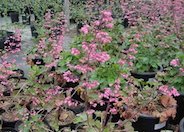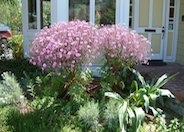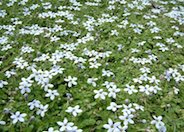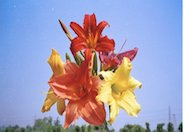
Common name:Bear's Breech, Acanthus
Botanical name:Acanthus mollis
This perennial produces large clusters of glossy foliage that is deeply lobed. Its leaves may reach lengths of 2'. The tall, purplish-white flower spikes are usually seen in late spring to early summer. It can be used as an accent plant. Acanthus is an effective, shade loving, herbaceous shrub.

Common name:Wendy Alum Root
Botanical name:Heuchera 'Wendy'
Heuchera 'Wendy' belongs to the group of large leaf (H. maxima), native, Heuchera hybrids that prefer, dry, shady conditions. They thrive under native oak trees or in similar situations. Once established, they require virtually no care other than removal of the dead flowers after bloom in the spring. They are most effectively shown when planted in mass.

Common name:Magenta-Eyed Geranium
Botanical name:Geranium maderense
This is one of the most dramatic, shade loving perennials of the garden. It has large lobed leaves on tall, arching red stems. During the summer, pink flowers with darker pink centers cover the plant. It grows up to 3' tall and wide.

Common name:Blue Star Creeper, Isotoma
Botanical name:Pratia pedunculata
Pratia pedunculata has bright green, nearly stemless, 1/4" leaves. In late spring and summer, these form a backdrop for equally tiny, star-shaped pale blue flowers.

Common name:Hybrid Daylily (various)
Botanical name:Hemerocallis hybrids
These summer-blooming perennials form clumps with large, grass-like leaves. Its showy flowers, resembling lilies, are borne in clusters on stems held well above the foliage. They prefer full sun to light shade, well draining soil that is slightly acidic and rich. They do better with deep watering once a week. Daylilies make excellent cut flowers. Apply a layer of compost every fall.
| Designer: Unknown | LA General Two 1 |
Photographer: GardenSoft |
Soils and Compost:
Physical weed control, including mulching, or hand removal protects the watershed from harmful chemicals.
Water Saving Tip:
Be sure to fix all leaks promptly no matter how small they may seem.
Integrated Pest Management:
Develop healthy soil for plants that are vigorous and naturally pest-resistant.
